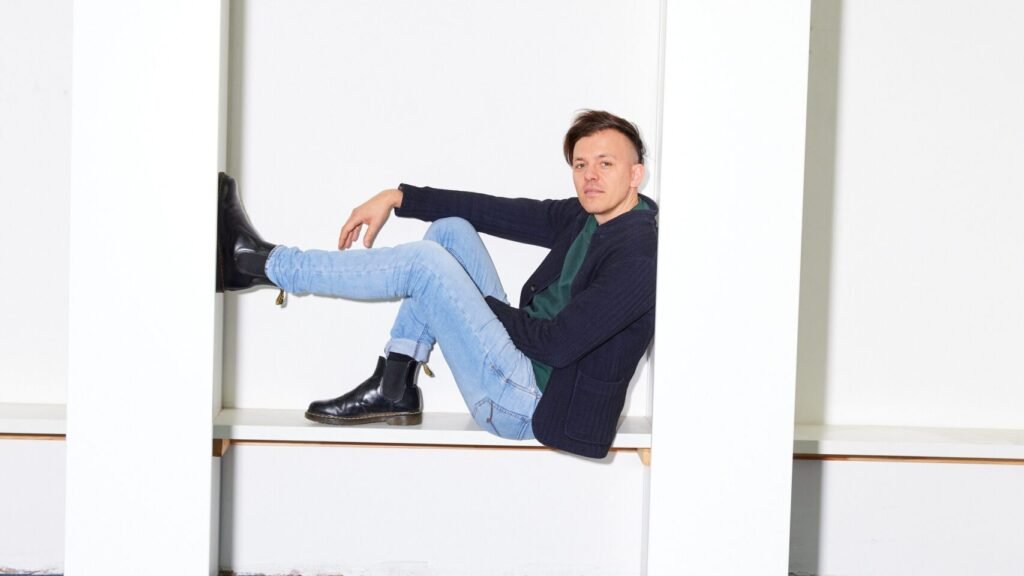It all began on what Moritz Simon Geist now calls “an ordinary Tuesday afternoon.” At the time, he was a research engineer in a German semiconductor lab, surrounded by fluorescent lights and the constant hum of robotic machines. His days were filled with spreadsheets, lab reports, and the same repetitive routines.
One day, he looked up from his Excel sheets and saw a future that felt unbearably linear, years of doing the same thing. Right then and there, he made a bold decision: to quit and bring a radical idea to life, to merge robotics with music and become a full time artist.
What happened next was anything but ordinary. Within a year, Moritz was performing live techno shows in the US with a robotic drum machine that went viral online. Today, he’s known globally as the pioneer of robot techno, an artist who creates physical, mechanical instruments that produce electronic music in ways a laptop never could.

From Childhood Dreamer to Robotic Maestro
As a child, Moritz was drawn to both classical music and machines. He played the clarinet and piano, and at the same time, he was fascinated by technology. He admired people like Buckminster Fuller, individuals who proved that you don’t have to pick between being an inventor or an artist. You can be both.
Though he earned a PhD in robotics and worked in academic research, Moritz felt stifled. The slow pace of academia couldn’t match his flood of ideas. So he left. He turned his tiny apartment into a makeshift studio and began building his first music robots, one motor and one sensor at a time.

It wasn’t easy. Funding was tight. Prototypes failed. And building robust, tour ready machines from garage experiments was no small feat. But what he lacked in resources, he made up for in persistence.
Over time, his DIY workshop evolved into a full scale robotic music studio in Dresden. It’s now a space where research, sound, AI, and chaos come together with a team ready to prototype ideas at any hour. Yes, sometimes even midnight.
Building Robotic Sound Poems
What sets Moritz apart isn’t just that he builds robots, it’s that he builds musical robots. Machines that don’t just move or beep but play, groove, and glitch their way into your senses.
Some of his most exciting inventions include:
- A life sized robotic drum machine that pays tribute to the legendary Roland 808
- Glitch robots made from recycled hard drives and 3D printed parts that deliberately create imperfect rhythms
- Tripods One, a robotic trio performing live techno music with pinging arms and hypnotic movement
- Vibrations, an installation where robot arms gently strike vibraphone bars to create melodic patterns
These machines don’t hide the fact that they’re robots. Their clicks and ticks are part of the sound. But that’s what makes them human in a strange, endearing way. Their imperfections and unpredictability breathe life into the music.
Performing the Physical Future of Music
Electronic music is often criticized for being too digital, cold, detached, and hidden behind screens. Moritz turns that stereotype upside down. His performances are deeply physical. You see every beat, every strike, every movement.
Imagine standing in a concert hall, watching a robot arm hit a drum while another one plucks a metal string, all perfectly in rhythm. There’s no DJ hiding behind a laptop. The robots are the band, and they’re right in front of you.
His shows have toured across Europe, North America, and Asia, captivating crowds who’ve never seen anything like it. It’s not just a concert, it’s a theatrical experience. A robot orchestra that dances, performs, and sometimes surprises even the artist himself.
Milestones, Records, and Recognition
One of Moritz’s biggest career highlights came when he released the world’s first techno record made entirely by robots. Every sound, every beat, every note was physically created by machines he designed. The album made waves in the electronic music world and established him as a true innovator.
Then came Hard Times Soft Sounds, an entirely different type of project. During the pandemic, Moritz created a meditative sculpture using a seashell suspended in water, rotated by a tiny motor. As it moved, it produced gentle, ambient tones, a piece of art designed to reflect stillness, slowness, and softness in chaotic times.
That piece was exhibited in Athens and at the Venice Music Biennale and later became his first collector’s item. It marks a more reflective turn in his work, proof that even techno robots have a soft side.
Teaching, Collaborating, and Asking Big Questions
Moritz isn’t just building machines, he’s helping build minds too. Over the years, he’s taught students about art, sound, and technology, encouraging the next generation of creators to think outside the box.

He’s also collaborated with artists, designers, and musicians around the world. His work has been shown in leading festivals and exhibitions, gaining respect not just in music, but in contemporary art circles.
Now, he’s diving into one of his boldest projects yet, Automating Empathy. The idea? To explore whether robots on stage can trigger emotional responses in humans. Can a machine make you feel joy, sadness, or wonder? Can empathy be automated?
Moritz doesn’t claim to have the answer. But as someone working at the cutting edge of sound and robotics, he sees it as his job to ask the question.
Lessons from 15 Plus Years of Chaos and Creativity
Looking back, Moritz sees his journey as a mix of curiosity, risk, and persistence. He has a few lessons that he often shares:
- Consistency matters. If you dedicate 10000 hours to anything, even something as niche as robot techno, you can become one of the best
- Failure is your friend. He wishes he had learned to fail faster and more fearlessly
- Weirdness works. The ideas people laughed at, like popcorn triggered robots, are now part of his signature style
And yes, about that popcorn drum kit: don’t test it near a hungry audience. You’ve been warned.
Machines with Soul
At the heart of it all is one powerful belief: technology doesn’t have to be cold or intimidating. It can be poetic, playful, even a little absurd.
Moritz hopes that when someone sees his robots on stage, whirring, clicking, and dancing, they feel something more than curiosity. Maybe even wonder. Maybe even emotion.
If audiences walk away thinking, “Wow, machines can have soul too,” then he knows he’s done his job.
He wants to be remembered not just as an engineer or artist, but as someone who helped bridge the gap between humans and machines, who proved that the most advanced technology can still be deeply, beautifully human.
What’s Happening Now
Moritz is busier than ever, with exciting projects and exhibitions around the globe:
- Studio life in Dresden: His lab is still buzzing with experiments and wild ideas
- Automating Empathy: Exploring if machines can express or evoke real human feelings
- Collector’s Edition Art: Hard Times Soft Sounds now exists as a limited signed series
- New shows and tours: Robot performances are heading to more stages around Europe
Why His Story Matters
In a world where technology often feels abstract or overwhelming, Moritz Simon Geist brings it back to earth literally. His robots are real. They’re loud. They’re unpredictable. They make music you can feel.
His story is proof that a single decision, a brave leap on an average afternoon, can change everything. That it’s okay to walk away from the expected path. That it’s worth betting on your curiosity.
Whether you’re an artist, a coder, or just someone dreaming of something different, Moritz’s journey reminds us: the future doesn’t have to be boring. It can dance. It can glitch. It can even sing.
Do follow him on Instagram
Read More: Transform Anxiety Into Strength When You Feel Like Everyone’s Ahead














